
About UsThe Numismatic Bibliomania Society is a non-profit organization promoting numismatic literature. For more information please see our web site at coinbooks.org SubscriptionsThose wishing to become new E-Sylum subscribers (or wishing to Unsubscribe) can go to the following web page link MembershipThere is a membership application available on the web site Membership Application To join, print the application and return it with your check to the address printed on the application. Membership is only $15 to addresses in the U.S., $20 for First Class mail, and $25 elsewhere. For those without web access, write to: David M. Sundman, Secretary/TreasurerNumismatic Bibliomania
Society AsylumFor Asylum mailing address changes and other membership questions, contact David at this email address: dsundman@LittletonCoin.com SubmissionsTo submit items for publication in The E-Sylum, just Reply to this message, or write to the Editor at this address: whomren@coinlibrary.com
BUY THE BOOK BEFORE THE COINYou won't regret it! |
- WAYNE'S WORDS: THE E-SYLUM JULY 20, 2008
- LAKE BOOKS 94TH NUMISMATIC LITERATURE SALE CATALOG AVAILABLE
- NBS CLUB TABLE AT THE ANA CONVENTION IN BALTIMORE
- BOWERS DONATES ADVENTURES WITH RARE COINS COVER PASTEUPS
- MANUSCRIPT: AN AMERICAN NUMISMATIST IN LONDON
- NEW BOOK: DAHLONEGA’S GOLD BY ANNE DISMUKES AMERSON
- NEW BOOK: PROFITABLE COIN COLLECTING BY DAVID GANZ
- NEW BOOK: A POCKETFUL OF HISTORY BY JAMES NOLES
- BOOK REVIEWS: A GUIDE BOOK OF UNITED STATES TOKENS AND MEDALS
- BOOK REVIEW: SUPERINTENDENTS OF THE 1ST & 2ND SAN FRANCISCO MINTS
- JRCS PROGRAM ON NEWMAN EARLY DOLLARS, QUARTER DOLLARS AND LIBRARY
- MORE ON THE PENNELL COUNTERFEIT DETECTOR REPRINTS
- DICK JOHNSON: BUTTONS HAVE CLOSE RELATIONSHIP TO COINS
- MORE ON ADJECTIVES IN AUCTION CATALOG DESCRIPTIONS
- THE FRANK STEWART CONGRESS HALL U.S. MINT COLLECTION
- "JB" TOKEN SIMILAR TO A KNOWN NOVA SCOTIA PIECE
- COUNTERFEIT U.S. $20 GOLD COIN MADE INTO A SPUR
- DEFINITIONS FOR DIFFERENT DIE TESTS
- NEWSPAPER PROFILES MYRON XENOS OF THE MONEY TREE
- GENE HESSLER BIO AND OTHER GLEANINGS FROM THE JULY 2008 NUMISMATIST
- HARTZOG'S ANA CONVENTION EXONUMIA GUIDE ENTERS ITS 26TH YEAR
- GLEANINGS FROM RECENT CATALOGS: STACK'S JULY 2008 SALES
- TALE OF TWO CITIES: COINAGE METAL'S DIFFERING EFFECT ON COMMUNITIES
- THE GREEN LADY OF THE ROYAL MINT
- GOLD COIN FOUND AT NEWFOUNDLAND COLONY SITE: LORD BALTIMORE'S POCKET CHANGE?
- CROWDS RUSH TO PURCHASE NEW CHINESE OLYMPIC COMMEMORATIVE BANKNOTES
- CHINESE COPIES OF COLLECTIBLE BANKNOTES
- COUNTERFEIT CASH SMUGGLED FROM TAIWAN IN FISH TINS
- FEATURED WEB PAGE: ANS NUMISMATIC RESOURCES ON THE INTERNET
WAYNE'S WORDS: THE E-SYLUM JULY 20, 2008
 Among our recent subscribers are Steve
Whitfield, courtesy of John and Nancy Wilson, and Denise Lund. Welcome
aboard! We now have 1,164 subscribers
Among our recent subscribers are Steve
Whitfield, courtesy of John and Nancy Wilson, and Denise Lund. Welcome
aboard! We now have 1,164 subscribersThis week we open with the latest Lake Books numismatic literature sale, and information about NBS events at the upcoming ANA convention. Next up are a new book on the Dahlonega gold rush and a new title from David Ganz.
Books reviewed this week include the new Guide Book of U.S. Tokens and Medals and Superintendents of the 1st& 2nd San Francisco Mints. Among topics introduced in previous weeks, we discuss the Frank Stewart Collection of U.S. Mint artifacts.
In the news this week, Myron Xenos of The Money Tree is profiled, author Gene Hessler is profiled in The Numismatist, and crowds rush to buy the new commemorative Chinese Olympic banknote. To meet the Green Lady of the Royal Mint, read on. Have a great week, everyone.
Wayne Homren
Numismatic Bibliomania Society
LAKE BOOKS 94TH NUMISMATIC LITERATURE SALE CATALOG AVAILABLE
The 383-lot catalog features selections from the library of Col. Bill Murray, a columnist for "Coin World" for many years. Bill has consistently vouched for the dictum "buy the book before the coin" in both his writings and his personal collecting habits.
Another consignor is John Hamilton of West Palm Beach. Volumes from John's library will appear in several of our sales in the coming year.
Highlights include: a bound volume of "The Numismatist" for the years 1896 and 1897, books on coinage and medals by Le Menestrier and Vaillant written in the 1600s and 1700s, a full set of the Haxby volumes on Obsolete Bank Notes, a set of Fauver's works on American Counters, John Adams' two-volume set on numismatic literature, Elvira Clain-Stefanelli's 1985 "Numismatic Bibliography", plus many other subjects relating to the numismatic collecting experience.
NBS CLUB TABLE AT THE ANA CONVENTION IN BALTIMORE
Howard A. Daniel III, will man a club table for the Numismatic Bibliomania Society at the World's Fair of Money in Baltimore. Howard will also represent the International Bank Note Society (IBNS), Numismatics International (NI), and the Philippine Collectors Forum (PCF). Packets with a banknote from IBNS (and coins from NI) will be given to young and new numismatists in the name of IBNS and NI at this club table. And numismatic references will also be given to serious new collectors, scout counselors and teachers.NBS Members attending this show can contact Howard to volunteer to help man the club table. Anyone with coins, notes and/or references they want to donate can bring them to the club table and receive a donation thank you letter from Howard. Please contact Howard at HADaniel3@msn.com if you have any questions about the show or donations of coins, paper money and/or references for giving out to young and new collectors.
BOWERS DONATES ADVENTURES WITH RARE COINS COVER PASTEUPS
In a letter dated July 9, 2008, Q. David Bowers writes: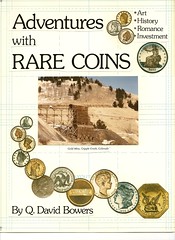
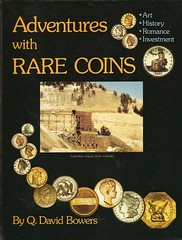
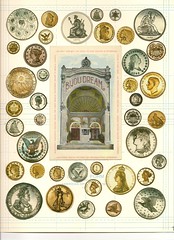

MANUSCRIPT: AN AMERICAN NUMISMATIST IN LONDON
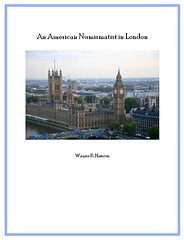 Another item up for bids at the Numismatic Bibliomania
Society membership meeting is a signed copy of a manuscript compilation of
my London Diaries from last year's E-Sylum. I spent most of last summer
living and working in Central London. Along the way I squeezed in time to
visit some numismatic friends and locations, and documented my travels in
my weekly diary. I've gotten numerous compliments from readers, many of
whom suggested publishing a book.
Another item up for bids at the Numismatic Bibliomania
Society membership meeting is a signed copy of a manuscript compilation of
my London Diaries from last year's E-Sylum. I spent most of last summer
living and working in Central London. Along the way I squeezed in time to
visit some numismatic friends and locations, and documented my travels in
my weekly diary. I've gotten numerous compliments from readers, many of
whom suggested publishing a book.As a first step I've compiled the diaries in book form and added section headings, a Table of Contents, Preface and Acknowledgements. Joel Orosz has provided a Foreword. A copy of the current draft, housed in a three-ring binder, will be auctioned at the meeting with proceeds to benefit NBS.
NEW BOOK: DAHLONEGA’S GOLD BY ANNE DISMUKES AMERSON
David Crenshaw of Whitman writes:The author, Anne Amerson, will be the guest speaker at the Southern Gold Society's annual gathering on Saturday, August 23 at the Whitman Coin and Collectibles Atlanta Expo. For more information about the SGS and its gathering, visit www.southerngoldsociety.org/about.html.
For show information, visit www.whitmanexpo.com.
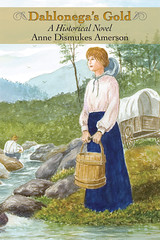 The story of Dahlonega, Georgia, is told in a
historical novel recently published by the University Press of North
Georgia.
The story of Dahlonega, Georgia, is told in a
historical novel recently published by the University Press of North
Georgia.Dahlonega’s Gold, by Anne Dismukes Amerson, brings to life America’s first major Gold Rush, the tragedy of the Trail of Tears, the drama of the Civil War, and other turbulent events in both Dahlonega’s and America’s history. The tale is told through the experiences of the independent young Keziah Hamilton Cochran.
Amerson's presentation will focus on the Dahlonega's gold rush and U. S. Branch Mint, the miners who left Georgia to go to the California gold rush, and the Russell brothers' role in the Pike's Peak gold rush. The program will begin at 11 a.m., Saturday, August 23 in meeting room 109.
Afterwards, there will be a book signing on the bourse in Hall A. Dahlonega’s Gold may be purchased ($19.95 + $3.95 shipping and handling) from the University Press of North Georgia on-site, or in advance by contacting B. J. Robinson, Department of English, North Georgia College & State University, Dahlonega, GA 30597 or calling 706-864-2964.
The Whitman Coin and Collectibles Atlanta Expo will be at the Cobb Galleria Centre in Atlanta Thursday–Saturday, August 21–23. There will be dealers from across the country with coins, currency, supplies, and books for sale. The show will be open to the public from 10:00 a.m. to 6:00 p.m. each day. Admission is free. For the latest information about the show, visit whitmanexpo.com.
For more information on the book see: www.upnorthgeorgia.org
NEW BOOK: PROFITABLE COIN COLLECTING BY DAVID GANZ
David L. Ganz writes:
NEW BOOK: A POCKETFUL OF HISTORY BY JAMES NOLES
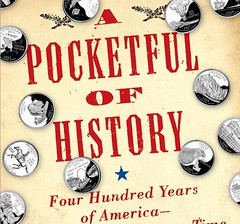 James Noles is a West Point graduate and a
Birmingham attorney who has created a second career for himself, not as a
novelist in the now overcrowded tradition of John Grisham, but as an
independent historian.
James Noles is a West Point graduate and a
Birmingham attorney who has created a second career for himself, not as a
novelist in the now overcrowded tradition of John Grisham, but as an
independent historian.Noles published 'Hearts of Dixie,' short portraits of 50 Alabamians including the hugely famous like Paul Bryant and Helen Keller and the not-so-famous like Erskine Hawkins and Carrie Tuggle.
This book, 'A Pocketful of History,' is organized very much like 'Hearts of Dixie.' In fact there are 50 short chapters telling the story behind each of the images on the new U.S. state quarters.
Noles reports that Maine's quarter, with a rendering of the Pemaquid Point lighthouse and the three-masted schooner Victory Chimes, is thought most aesthetic. Michigan, with an outline map of the state and lakes, 'most boring.'
Here in Alabama, we have put Helen Keller on the state quarter. Noles tells his readers that not only was Miss Keller a genius, blind and deaf, but able to learn to read and write not only English and Braille but also French, German, Latin and Greek. This some Alabamians knew, but Noles reminds his readers that Miss Keller was a socialist, supported Eugene Debs, fought for safer conditions in factories, favored women's suffrage and was in support of the Republican side in the Spanish Civil War. Noles omits commentary of Keller's 'private' life, but interested readers may consult the same source Noles did, Dorothy Herrmann's Helen Keller: A Life. In fact, any of these brief entries might spur a reader to more extensive exploration of the topic.
The pattern in each entry is essentially the same. The story of the Statue of Liberty on the New York coin is briefly told. For South Dakota it is the carving of the faces on Mt. Rushmore. Sometimes the reader will know this story already, sometimes not. The very first entry, Delaware, was one of my favorites. It's the story of Cesar Rodney, who, having lost the left side of his face to skin cancer, got up out of a sick bed and traveled 80 miles in the rain to the Continental Congress in Philadelphia to vote for independence. This entry, like many, was educational and inspirational.
This review was originally broadcast on Alabama Public Radio.
To read the complete article, see: Author shares history of images on nation's quarters (http://www.tuscaloosanews.com/article/20080720/NEWS/
609457651/1007/news02&title=Author_shares
_history_of_images_on_nation_s_quarters)
BOOK REVIEWS: A GUIDE BOOK OF UNITED STATES TOKENS AND MEDALS
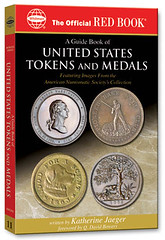 This week I received a copy of Katherine Jaeger's
new book from Whitman Publishing, A Guide Book of United States Tokens
and Medals. I published my reactions earlier to a set of sample pages
forwarded by Whitman. Now that I have the complete book in hand I thought
I'd add to my observations.
This week I received a copy of Katherine Jaeger's
new book from Whitman Publishing, A Guide Book of United States Tokens
and Medals. I published my reactions earlier to a set of sample pages
forwarded by Whitman. Now that I have the complete book in hand I thought
I'd add to my observations.As expected, this is an extremely useful book, both for the general public and more advanced numismatists. The color photos, taken mostly from the American Numismatic Society collection, are wonderful and a major feature of the book. Where else can you page through such a vast array of interesting numismatic items?
I believe this book will find its niche among the general collecting public - it makes a great companion to the standard Guide Book of United States Coins. Nearly every major type of token or medal a collector might come across (in the U.S. anyway) is represented here, from dirt common to ultra rare.
In the common category would of course be things like sales tax tokens, subway, bus and parking tokens, Mardi Gras doubloons, ration tokens, arcade tokens, pop-out come coins and the like.
In the latter category, some of my favorites are abolition pieces, encased postage stamps, historical commemoratives of 1858-1861 (a chapter contributed by Dave Bowers), and art medals (including the Society of Medalists and the Circle of Friends of the Medallion).
If I were to suggest an enhancement for future editions, it would be some sort of finding guide to help direct readers to the particular chapter where an item in question might be found. This is a tall order for such a vast field, yet experienced collectors can tell in an instant what category most such items fall under. Clues of size, shape, style, design and wording help differentiate these pieces; if numismatists can come up with attribution guide for such similar pieces as bust halves or early large cents, surely some clever person can codify a similar algorithm for tokens and medals.
I recommend the book for collectors at every stage in the hobby from beginner to advanced - everyone should find some chapters of interest and many will find one day that some of the sections (and value guides) come in quite handy.
This soft covered book is priced at $19.95, and can be purchased at www.whitmanbooks.com or from a numismatic literature dealer or major book store.
This excellent reference gives a nice overview of metals and tokens with useful information for the expert as well as beginner. It covers from the Colonial Period right up to elongated coins of today. The photos of the tokens and medals are done in vivid color. Since it is a pricing guide it will give you a general ideal of the worth of a similar item you may have in your collection.
We found in Part II, Chapter 13 a very informative story on the Coin Medals of the Franklin Mint. When you think about it, the Franklin Mint at one time produced products for customers around the world who were not only numismatists but non numismatists. The history of this fascinating company is consolidated into eight pages, which include examples of their work. This chapter alone will give the non-collector who owns products from this mint information that can be obtained no other place. Because of legal concerns the book does not cover U. S. military medals, orders, and decorations. Also excluded are orders and decorations of clubs, fraternal societies, civic organizations, slave tags, clothing buttons, badges, dog tags, bracelet charms, watch fobs, sports medals (all kinds), religious medals, communion tokens and Judaic exonumia.
Tokens and Medals are an important part of the American History and this book will help immensely to generate many new collectors into collecting them. We enjoyed reading it and it now has a place in our numismatic library. Congratulations Ms Jaeger for you have done a super job in authoring this fine reference.
BOOK REVIEW: SUPERINTENDENTS OF THE 1ST & 2ND SAN FRANCISCO MINTS
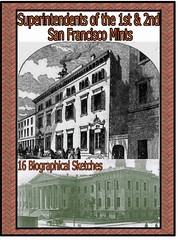 This week I received my copy of
Superintendents of the 1st & 2nd San Francisco Mints by Richard
Nancy Oliver & Richard Kelly.
This week I received my copy of
Superintendents of the 1st & 2nd San Francisco Mints by Richard
Nancy Oliver & Richard Kelly.This 41-page spiral-bound book is printed on glossy stock with sturdy laminated covers. It is divided into twenty short chapters packed with pictures and biographical information about all of the men who held the important job of San Francisco Mint superintendent from 1853 through 1944. The mostly black and white illustrations are sometimes fuzzy, yet are likely the only available images.
The bios make for interesting and enlightening reading. Going beyond the requisite birth and death dates and career and family history, the authors include numerous stories of people, incidents and events surrounding the mint. For example:
The carpet was burned in the furnace so that the precious metals within it could be recovered. On April 30, 1861 a fire broke out in the assaying department:
The book of course touches on the Mint's harrowing ordeal in the 1906 earthquake and fire. It also discusses a secret transfer of $270 million in gold coin to the Denver Mint in 1908 (p32). One of my favorite stories is that of the silver dollar avalanche of 1933:
No sooner than he made his way out of the vault door, when the 29,000,000 silver coins began to move. With a huge roar, the coins burst thorough their sacks, and filled the passageway where Michael had stood just moments before. The coins continued to escape their rotted sacks, spilling out the vault door and into the corridor.
It took two months, and the work of 14 men, to gather the coins, to weigh them, and to count them...
I noticed at least one typo in the book (page 9: "there was a charge of administration"), and the coin images could have been much better. But these are small matters; the book succeeds in its purpose. For the first time in one publication, we have a compilation of biographical and historical information on the important but heretofore obscure public servants responsible for creating the classic coinage of the San Francisco Mint. It's a thin volume, but it filled a wide gap in my shelf of references on the branch mints of the U.S.
To learn which Superintendent died of a stroke while decorating a Christmas tree, order a copy of the book! The authors have made this offer to readers of The E-Sylum:
I shared my review with the authors, who add:
Second, yes a few of our images of the Superintendents came fuzzy, especially Peter Lott, and Nancy worked hard to bring them clear with our software. The Lott photo came from a portrait on a wall of the Supt's office, which was almost invisible. But Nancy pulled it out, and I was generally shocked that she even got it that clear. And as well, a portrait of Stevens, after six months of search, was surprisingly unobtainable. We know for a fact that portraits of maybe all of the Supt's were on the walls of the Superintendent's office, but after questioning Washington DC, Director Moy, etc., no one seems to know if they still exist. We have tried to make the book of the best quality, and you have made us feel good that we have mostly accomplished that. And yes, the Michael Kelly story of the falling silver dollars is also one of our favorites.
THE BOOK BAZARRE
COMING AUCTIONS • MARK YOUR CALENDAR
• September 18, 2008 Mail Auction Featuring 19th & 20th Century Coin Sales from the Ford Library
PUBLIC AUCTIONS • NEW YORK INTERNATIONAL NUMISMATIC CONVENTION THE WALDORF ASTORIA HOTEL • NEW YORK CITY • JANUARY 10TH, 2009
• The Dr. Ferdinando Bassoli Library of Antiquarian Numismatic Books & Italian Numismatic Works
• The Twinleaf Library, Featuring Classic Plated American Auction Sales & Key Works on Large Cents GFK@numislit.com GEORGE FREDERICK KOLBE (909) 338-6527
JRCS PROGRAM ON NEWMAN EARLY DOLLARS, QUARTER DOLLARS AND LIBRARY
Members are invited and guests are welcome. Dave Perkins and Rory Rea will be presenting this year's club program. You won't want to miss it! Dave and Rory will be talking about the Eric P. Newman (EPN) collection of early dollars and quarter dollars, with slides of the visit and the coins from this collection. All of the coins are ex. Col. E.H.R. Green, and have been stored in Waite Raymond holders since the 1940s when Eric acquired them from the Green estate. Needless to say there are a large number of beautifully toned coins.
A number of the silver dollars are plate coins in the Bowers silver dollar book, and via a little detective work (and plate matching) many of the quarter dollars are plate coins in the original Browning book! You will also get a glimpse of the extensive EPN Library and Museum. And maybe a few very interesting letters and "old envelopes" to boot!
MORE ON THE PENNELL COUNTERFEIT DETECTOR REPRINTS
Regarding the counterfeit detector reprints produced by Roy Pennell, numismatic literature dealer George Kolbe writes:We also sold special interleaved green leather-bound copies of both in our 39th sale from the library of Bob Medlar. Only ten copies of each of these were produced.
DICK JOHNSON: BUTTONS HAVE CLOSE RELATIONSHIP TO COINS
You see, Matthew Boulton was a buttonmaker before he developed an interest in coining and went on to establish his Soho Mint, became the great innovator in coin and medal technology, and lead the force in the development of the Industrial Revolution. Numismatic encyclopedist Ewald Jung said that the best coin and token makers were once buttonmakers, and that these included Mathieru, Mercié & Mouterde in Lyon, Roche in Dublin, in addition to Boulton in Birmingham.
Presses for striking buttons could also be used for striking coins and tokens. Die making was exactly the same and compositions for making both were nearly the same. Prior to Boulton, a new technology developed for die striking buttons was applied to coin and token striking. But Boulton turned both fields around with his advancements in diestriking technology and equipment. He is the number one developer who should be considered the Father of coin & medal technology.
The same closeness was true in America. Scovill in Waterbury were buttonmakers in 1802 before they struck their first token in 1829. With the same equipment and the same technology it was a logical evolution. In fact, the two fields advanced along parallel lines. Scovill went on to produce billions of buttons over almost 200 years! It also became America's "Secret Mint," creating tokens of all kinds, coin blanks for the U.S. Mint, and even struck coins for foreign governments. When the U.S. Mint could not produce some item quickly enough -- like the 1893 Columbian Exposition Award Medal -- it turned to Scovill.
I didn't realize the closeness of the two fields until the sale of equipment when Medallic Art Company's Danbury plant was closed in February 1991. The key pieces of equipment were the seven die-engraving pantographs. One or two of these went to medal makers, all the rest went to firms that manufactured buttons!
MORE ON ADJECTIVES IN AUCTION CATALOG DESCRIPTIONS
Dave Bowers writes:
The long legal notices published by the DEA in newspapers, offering seized coins for sale, have no adjectives at all, and offer a rich opportunity for adjective-phobes to do some bedside reading.
I for one like adjectives, and within the context of numismatics I think that many coins, situations, and events can indeed be “important.”
Isn’t it delightful that there are so many people with so many diverse and interesting (pardon the adjective) commentaries on what we all do?
THE FRANK STEWART CONGRESS HALL U.S. MINT COLLECTION
Joel J. Orosz writes:
This reminds me of Phillipe de Montebello promising a major donor that the donor's name would be attached to a gallery at the Metropolitan Museum of Art "in perpetuity." The donor shrewdly asked, "How long does 'perpetuity' last?" Montebello candidly replied "Fifty years." In answer to the Editor's question, Len Augsburger and I have recently done research at the Independence Hall Library, and Len has done research at Rowan University's Stewart Collection, all for our forthcoming Whitman book, Pictures of the First United States Mint: The Numismatic Legacy of Frank H. Stewart.
Both repositories have been very helpful, and have allowed us to directly examine artifacts from Stewart's collections. Neither repository has numismatics as a primary competence, but the curators at both have been interested in learning from us, and certainly care deeply about the important numismatic artifacts under their care.
"JB" TOKEN SIMILAR TO A KNOWN NOVA SCOTIA PIECE
Last week in my numismatic diary I pictured a token belonging to Tom Kays. It's an English half penny of George I with script initials "JB" and "1812". It rang a bell with David Gladfelter, who writes: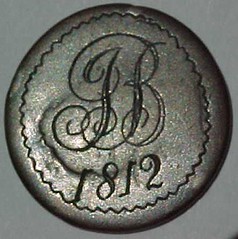

COUNTERFEIT U.S. $20 GOLD COIN MADE INTO A SPUR
Dave Wnuck writes:In response, Tom Kays writes:
I find no alternative lettering as expected on a spielmark, yet that is a possibility that I cannot rule out as it seems shallowly struck, but of good die work. I’d feel better that it was meant to deceive, if it had gilt or leaf remaining, or if it were heavy, approximating proper gold weight. It has good dug patina and moderate porosity that would be hard to fake regarding age.
I think it is a neat relic and was probably Civil War camp made. The obverse is nearly obliterated but the reverse center at the eagle’s head and stars are clear. Pictures are of reverse, obverse, edge.
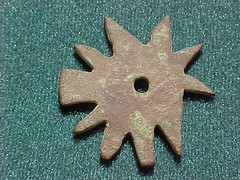
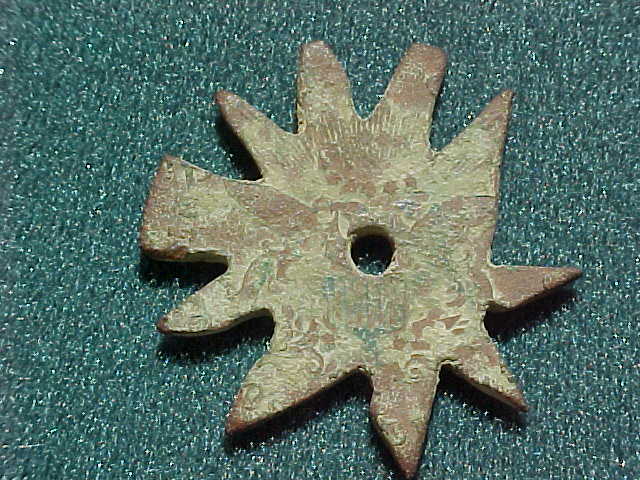
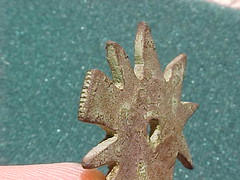
DEFINITIONS FOR DIFFERENT DIE TESTS
The best answer I could give for the last term was a first strike or early strike, fresh off the press, to be approved by some authority to continue the press run. I had not encountered this term before, but it certainly could have been employed by some pressman somewhere at some time. Perhaps it depends upon the size of the medal maker and how many employees are involved as to who would grant that permission. A pressroom foreman could make that decision, or a director of production, or the art director, or even the owner of the plant. If the client was on hand, even he could give the "go ahead." What you don't want to do, especially, is delay getting that approval. Idle time on the press is expensive.
A splasher is a term used only by hand engravers. While hand engraving of dies was employed for making dies for 2,000 years it was generally replaced about 1900 by pantographic reduction of oversize models. However even in our age of computer engraving now, hand engraving can still be employed to make dies. (Ron Landis in Arkansas, among others, is still hand engraving dies, keeping alive this technology.)
The hand engraver works at a bench. He can test the die he is engraving -- at any stage -- right at his bench by making a splasher. He has a small melting pot heated by a Bunsen burner where he melts soft metal, tin or lead. He places a piece of newspaper on his bench and pours a small puddle of this metal on the newspaper. While the metal is somewhat molten he presses the die into the metal by hand.
The metal hardens. The newspaper sticks to the back of the splasher (and is a diagnostic of a true splasher, even decades later). The engraver examines the metal splasher. He looks at the high points (to see that he has captured all the relief), then examins the most recent area of his engraving.
The die, of course is negative, the splasher is positive and is exactly what a struck piece would look like from that die. He either continues engraving, or if the die is satisfactory in every way, the die can then be hardened by heat treating -- tempering -- and be ready to be put on the press for striking.
A die trial is not the same as that medal proof, above mentioned. Dies are "proved" -- that is, give evidence they are complete and ready to be used for striking -- by making a lead proof. These are struck on a press using a soft metal blank, usually lead, with care not to damage the die with too heavy an impression with this first blow.
Lead proofs can be two-sided but more often only one side to exhibit all the relief on that one die (often the two dies are made at different times and not available to make a two-sided strike). Therefore, a pair of lead proofs are shown to the client for approval, one obverse, one reverse. This can be days before the dies are set up in a press, so any delay is not intolerable.
Splashers can only be made from one die. When no longer needed the splasher is tossed into the melting pot for the metal to be used over and over. The newspaper backing burns away. Single-sided lead proofs can be used twice (once for each side of the lead blank). Virgin lead proofs are usually made for clients (who usually keep them). Thus lead proofs are rather common, even though only one pair are made. On the other hand, true splashers are rarely found in the numismatic field but some still exist from the 19th century (with a tiny piece of newspaper stuck to the back!).
NEWSPAPER PROFILES MYRON XENOS OF THE MONEY TREE
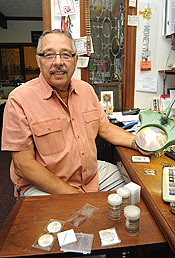 At The Money Tree, you’ll be assisted by Myron
Xenos, who has been in the buying and appraisal business for 45 years.
Xenos has been in the same Rocky River location for more than 30 of those
years. And in addition to his work at The Money Tree, he also serves as
the collectibles auctioneer for Channel 25’s annual May auction.
At The Money Tree, you’ll be assisted by Myron
Xenos, who has been in the buying and appraisal business for 45 years.
Xenos has been in the same Rocky River location for more than 30 of those
years. And in addition to his work at The Money Tree, he also serves as
the collectibles auctioneer for Channel 25’s annual May auction.
The Money Tree is a local business, meaning that Xenos works with local dealers when selling items, which is important to Xenos because he believes in making sure every customer gets a fair shake.
“Even the smallest platinum rings are worth something,” Xenos notes. Xenos will examine coin collections and estates, medals, paper money, any jewelry, old watches, sterling silver, platinum and more. Not sure if what you have is valuable? That’s not unusual; Xenos notes that of the countless silver dollars in existence, only some are rare.
What is in demand currently? Two markets that are doing particularly well, Xenos says, are gold and rare coins. After a long period of stagnation, the gold market recently began to boom again, Xenos says. And collectors will pay hundreds of thousands of dollars for some coins.
“The coin market is doing very, very well,” Xenos says.
To read the complete article, see: At The Money Tree, lost treasure is discovered (http://www.westlifenews.com/2008/07-16/bizprofile.html)
GENE HESSLER BIO AND OTHER GLEANINGS FROM THE JULY 2008 NUMISMATIST
 The July 2008 issue of The Numismatist
published by the American Numismatic Association has a number of items of
interest to bibliophiles. The feature article is a biography of author
Gene Hessler, winner of the ANA's 2008 Farran Zerbe award.
The July 2008 issue of The Numismatist
published by the American Numismatic Association has a number of items of
interest to bibliophiles. The feature article is a biography of author
Gene Hessler, winner of the ANA's 2008 Farran Zerbe award.Gene's an E-Sylum regular, and contributor to numismatic publications including Bank Note Reporter, COINage, Coin World, The Numismatist, and Paper Money, which he edited from 1984 to 1998. Gene also served as curator of the Chase Manhattan Bank Money Museum in New York and the Mercantile Money Museum in St. Louis.
The article, written by Fred Schwan, features a portrait of Gene with the numismatic books he's authored:
- Comprehensive Catalog of U.S. Paper Money
- U.S. Essay, Proof and Specimen Notes
- An Illustrated History of U.S. Loans
- The Engraver's Line
- The International Engraver's Line
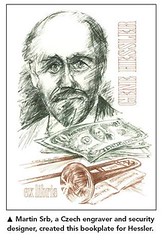 Gene will soon publish another book, a memoir of
his life titled Hey, Mr. Horn Blower. In Gene's other career as a
professional musician, he performed alongside legends Stan Kenton, Woody
Herman, Buddy Rich, Julie Andrews and others.
Gene will soon publish another book, a memoir of
his life titled Hey, Mr. Horn Blower. In Gene's other career as a
professional musician, he performed alongside legends Stan Kenton, Woody
Herman, Buddy Rich, Julie Andrews and others.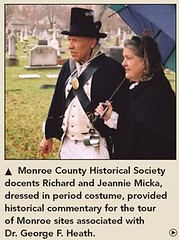 Also of interest to researchers and
bibliophiles is Just What the Doctor Ordered, an article about ANA
founder Dr. George Heath and efforts of the Michigan State Numismatic
Society to commemorate the 100th anniversary of heath's death
Also of interest to researchers and
bibliophiles is Just What the Doctor Ordered, an article about ANA
founder Dr. George Heath and efforts of the Michigan State Numismatic
Society to commemorate the 100th anniversary of heath's deathOther items of interest are an article by Benjamin Smith on the 16th century numismatic reference Illustrium Imagines, donated to the ANA library by its namesake Dwight Manley, and an article by David Lange on the Old San Francisco Mint and its research facilities. David writes:
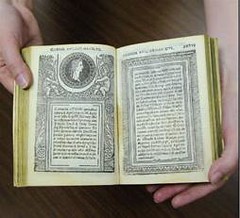
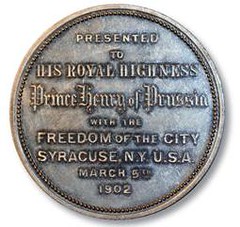 Lastly, I’ll mention a well-written and researched article by
David Schenkman on an interesting 1902 medal honoring a visit to Syracuse,
NY by Prince Henry of Prussia. Dave had brought the medal to a recent
meeting of my Northern Virginia social club, Nummis Nova, where I
got to view it close up.
Lastly, I’ll mention a well-written and researched article by
David Schenkman on an interesting 1902 medal honoring a visit to Syracuse,
NY by Prince Henry of Prussia. Dave had brought the medal to a recent
meeting of my Northern Virginia social club, Nummis Nova, where I
got to view it close up.Numismatists who aren’t members of the ANA are missing out on some great reading.
HARTZOG'S ANA CONVENTION EXONUMIA GUIDE ENTERS ITS 26TH YEAR
GLEANINGS FROM RECENT CATALOGS: STACK'S JULY 2008 SALES
 Lot 3081:
Daniel Webster. 1841/1837. Low-63, Rulau HT-21, DeW. CE.1838-5.
(http://www.stacks.com/lotdetail.aspx?lrid=AN00095437)
Lot 3081:
Daniel Webster. 1841/1837. Low-63, Rulau HT-21, DeW. CE.1838-5.
(http://www.stacks.com/lotdetail.aspx?lrid=AN00095437)
Lot 3144: New York. New York City. Dr. Lewis Feuchtwanger. Three Cents. 1837. (http://www.stacks.com/lotdetail.aspx?lrid=AN00095528)
Obverse and reverse types as Low-118 but counterstamped at the top of the reverse JMP in logotype. The counterstamp applied carefully with thought to its placement in the space between W and the leaf below it. Ford's was counterstamped just like this, too.
Who JMP was or why he thought to counterstamp his logotype on a scarce token is still a mystery.


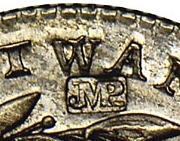
 Lot 3355:
Illinois. Chicago. C.D. Peacock. [1900]. Low-366, Rulau HT-M19
(http://www.stacks.com/lotdetail.aspx?lrid=AN00097898)
Lot 3355:
Illinois. Chicago. C.D. Peacock. [1900]. Low-366, Rulau HT-M19
(http://www.stacks.com/lotdetail.aspx?lrid=AN00097898)
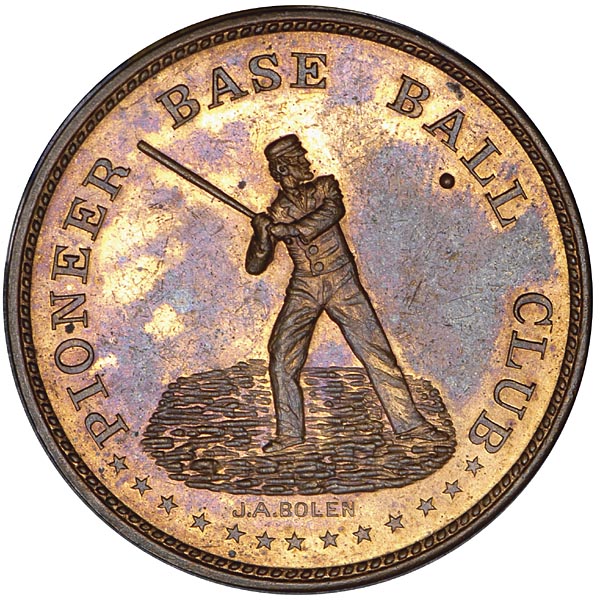 Lot 3443:
Massachusetts. Springfield. Pioneer Baseball Club. 1858. Miller Ma 529,
Bolen 1. (http://www.stacks.com/lotdetail.aspx?lrid=AN00098086)
Lot 3443:
Massachusetts. Springfield. Pioneer Baseball Club. 1858. Miller Ma 529,
Bolen 1. (http://www.stacks.com/lotdetail.aspx?lrid=AN00098086)
Lot
2239: 1850 Baldwin & Co. $10 gold. K-3. Rarity-6. Horseman or Vaquero.
(http://www.stacks.com/lotdetail.aspx?lrid=AN00104083)
Lot 3686: GREAT LOCO FOCO JUGGERNAUT (http://www.stacks.com/lotdetail.aspx?lrid=AN00104427)
A defining satirical cartoon in the form of a slightly oversized obsolete banknote of the period. Engraved by David Claypool Johnston, without imprint. The designs and texts are extremely detailed (easily the most complex of the period).

Lot 4314: 1837 Half Dollar (http://www.stacks.com/lotdetail.aspx?lrid=AN00102205)
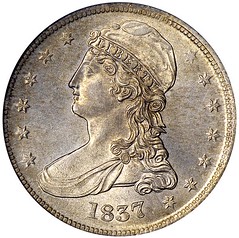

 Lot 2085:
1834-37 C. Bechtler $5 gold.
(http://www.stacks.com/lotdetail.aspx?lrid=AN00107971)
Lot 2085:
1834-37 C. Bechtler $5 gold.
(http://www.stacks.com/lotdetail.aspx?lrid=AN00107971)This is among the most interesting of all Bechtler issues from an historical viewpoint. It bears the day date of August 1, 1834. Bechtler was aware that the Coinage Act of June 28, 1834, changed the composition and weight of gold coins, making them lighter than before, permitting them to circulate once again. No gold coins had been seen in domestic circulation since 1820, for the international price of gold bullion was at a higher level than the face value imprinted upon federal coins. Coins that did circulate, including the Bechtler issues, were taken in not at their face value but based upon their bullion content, resulting in each selling at a premium.
TALE OF TWO CITIES: COINAGE METAL'S DIFFERING EFFECT ON COMMUNITIES
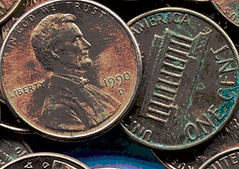 Greenville, in northeastern Tennessee, is the
home of the zinc plant of Jarden Industries. Its 200 employees have been
preparing blanks for the U.S. government's mints by copper plating zinc
discs of precise size. In fact, three-quarters of its business have been
these one-cent blanks, $104 million worth in 1907 alone, $275 since 2004
for this single product.
Greenville, in northeastern Tennessee, is the
home of the zinc plant of Jarden Industries. Its 200 employees have been
preparing blanks for the U.S. government's mints by copper plating zinc
discs of precise size. In fact, three-quarters of its business have been
these one-cent blanks, $104 million worth in 1907 alone, $275 since 2004
for this single product. Recently the Mint informed the firm it is not renewing its contract for zinc blanks, as the current contract expires September 30th. Talk among Congress is that it is learning toward cents struck in steel. With a drop of three-quarters of its business, layoffs are expected at one of the city's largest employers.
Things are gloomy in Greenville.
In contrast, Calumet in Michigan's Upper Peninsula is basking in higher copper prices while demand is holding steady. Calumet is the center of the copper producing area. They credit the U.S. cent for the founding of this prosperity. For a group of visitors a guide holds up a copper cent coin.
"It may be more or less worthless, but it's still of value for the story that's inside," says park ranger Dan Brown, holding up the coin.
That story is the centerpiece of Keweenaw National Park -- a park with no clear boundaries and little focus on natural beauty, though that's found in abundance in the region's untouched forests and along its craggy Lake Superior coastlines. The story is told through a loose collection of museums, historic buildings, mine tours and ghost towns that once were among the state's most thriving and affluent settlements and now are spread across the Keweenaw Peninsula.
Copper contributes to the area's prosperity.
For good news in Michigan's copper country: To read the complete article, see: Copper Country: National park brings copper-rush days to life in Western U.P. (http://www.mlive.com/travel/index.ssf/2008/07/
copper_country_national_park_b.html)
For bad news in Tennessee's zinc community: A Penny Saved? A supplier of the much-maligned coin tries to keep making cents (http://www.businesstn.com/pub/5_7/features/8581-1.html )
THE GREEN LADY OF THE ROYAL MINT
Bruce Perdue writes:Over the last 30 years, the Museum of London has excavated, examined and archived 17,000 skeletons. Now, 26 of them are to go on display at the Wellcome Trust in London.
This female skeleton was discovered at the Royal Mint, London, and dates to between 1350 and 1400.
The woman died between the ages of 26 and 35; but as her body lay buried, the copper waste produced from the coin manufacturer concreted her neck vertebrae together, and also stained her teeth and skull green.
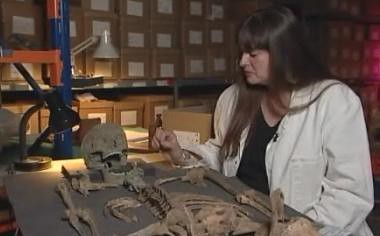
To read the complete article (and view the video), see: Tales from beyond the grave (http://news.bbc.co.uk/2/hi/science/nature/7509348.stm)
GOLD COIN FOUND AT NEWFOUNDLAND COLONY SITE: LORD BALTIMORE'S POCKET CHANGE?
Sometime around 1627 the owner of a gold coin lost it at an early British colony on Newfoundland's Avalon Peninsula.
Archeologist Jim Tuck, who dug the rarity out of the stone footing of a house last week at the Colony of Avalon, says how it got there is anybody's guess, but the erstwhile owner -- maybe the man who founded the colony in 1621, Lord Baltimore, himself -- didn't let it go very easily.
"It's probably the most unusual and valuable thing from this early period [ever found]. I don't know of any other [complete] gold coins from any other land archeological sites in eastern North America or Canada," said Tuck, who has been excavating the site of the colony since the early 1990s.
Tuck says when he first saw it, he didn't believe it.
"At first I thought it must be something that came out of the inside of a soft drink cap or something like that, you know, a piece of gold-coloured foil because you just don't expect anything like that," he said.
"[But] gold is such nice stuff -- it doesn't rust or corrode or anything. As soon as the dirt began to brush off you could see there was lettering around the rim and the crest and stuff. So it was pretty exciting for a few minutes there."
To read the complete article, see: Gold coin from 1627 unearthed at place of ex-British colony (http://www.canada.com/theprovince/news/story.html?
id=46d18781-24aa-4430-b0f5-92bf5efd84e6)
CROWDS RUSH TO PURCHASE NEW CHINESE OLYMPIC COMMEMORATIVE BANKNOTES

An anonymous client manager at the Huixinxijie branch of the Bank of Communications said: "People started queuing last night, and the 50 bills were sold out in less than half an hour after we opened at 8:30."
This latest issuance is the third time the central bank has printed special notes to commemorate a major event. The first was in 1999, to mark the 50th anniversary of the founding of the People's Republic of China, and the second was in 2000, to celebrate the new millennium.
The new 10-yuan note is greenish-blue in color and measures 148.5 mm by 72 mm, making it slightly larger than the regular note in circulation.
To read the complete article, see: Collectors queue all night for notes (http://www.chinadaily.com.cn/olympics/2008-07/10/content_6833669.htm)
Despite bad weather, long lines began forming as early as Monday. That was more than two days before the Olympic commemorative banknotes were due to be issued on Wednesday.
In the financial hub of Central, Hong Kong residents, including young children and pensioners, flocked to the main Bank of China branch at the crack of dawn. Some even hunkered down inside tents for a lengthy wait.
Although a severe thunderstorm on Monday night drenched thousands, the Bank of China was forced to issue banknote purchase vouchers to finally disperse the crowds. But fresh lines have quickly formed again.
To read the complete article, see: HK residents rush to get Olympic notes (http://www.cctv.com/program/bizchina/20080716/104608.shtml)
Many other China nationals in the queue also declined to be interviewed and avoided the camera.
A group of 10 people from Guangzhou took a train into Hong Kong after failing to secure the limited-edition notes back home, reported South China Morning Post.
A Guangzhou woman said: 'I think the banknotes are really valuable because a 10-yuan note on the mainland has become worth more than 1,200 yuan.'
She added, 'But even so, I am not going to sell them.'
Those in the queues include the elderly, families and young people.
Most had umbrellas for cover from the rain and the sun while some arrived with straw mats, plastic chairs and newspapers to prepare for the long wait.
Mr Tsui Chiu, owner of the Luen Fat Stamp and Coin Shop, said he had assigned more than 20 of his staff to line up at different Bank of China branches.
'The demand is huge,' he said. 'I've received a lot of calls from mainland and Hong Kong customers interested in buying.'
To read the complete article, see: Some are paid $350 to queue (http://newpaper.asia1.com.sg/news/story/0,4136,170925,00.html)
CHINESE COPIES OF COLLECTIBLE BANKNOTES
Howard A. Daniel III writes:
From the web site:
In the photos of the Chinese coin counterfeiting ring that my sources provided, there were very few banknotes shown. This photo is the best of the banknote bunch. The other items in the photo seem to be some kind of tourist-trade goods.

To read the complete article, see: Fake Chinese Currency and Goods (http://coins.about.com/od/worldcoins/ig/Chinese-Counterfeiting
-Ring/Fake-Chinese-Currency---Goods.htm)
To read an earlier E-Sylum article by Richard Doty, see: CHINESE FAKE FACTORIES MAKE BANKNOTES AS WELL AS COINS (http://www.coinbooks.org/esylum_v11n18a12.html)
COUNTERFEIT CASH SMUGGLED FROM TAIWAN IN FISH TINS
Mei Ling Chen, 46, was charged with bringing counterfeit currency into the United States.
Chen was arrested Tuesday at her former husband's home in Sunnyvale, four days after customs agents intercepted a package at San Francisco International Airport that had been shipped from Taiwan, authorities said in documents filed Wednesday in U.S. District Court in San Francisco.
The customs declaration described the package as a gift containing candy and books, Secret Service senior special agent William Bishop wrote in an affidavit. But when a customs agent opened the parcel to make sure it didn't contain prohibited food items, he found four pouches containing fake $100 bills wrapped in newspaper, Bishop wrote.
The pouches, holding $380,000 in fake bills in all, were hidden among 20 bags of dried seafood, authorities said.
The currency appeared to be "supernotes," fake money that is of such high quality that the fraud goes undetected until the cash reaches the Federal Reserve Bank, authorities said.
To read the complete article, see: Woman charged with smuggling counterfeit cash (http://www.sfgate.com/cgi-bin/article.cgi?f=/c/a/2008/07/17/BA5211QTEC.DTL)
FEATURED WEB PAGE: ANS NUMISMATIC RESOURCES ON THE INTERNET
This week's featured web page is recommended by John and Nancy Wilson, who write:www.numismatics.org/eresources/numsites.html
